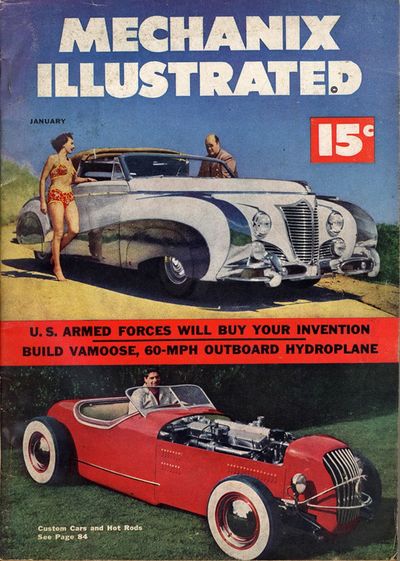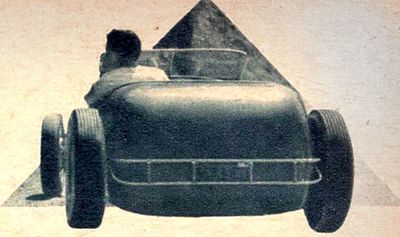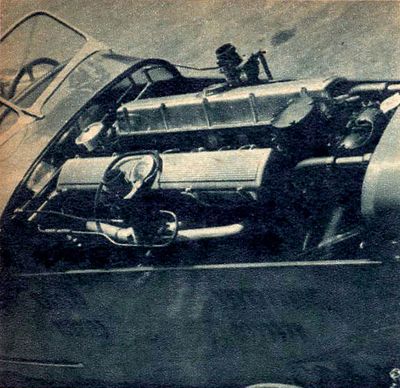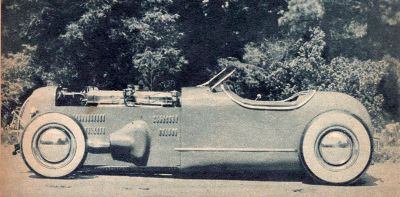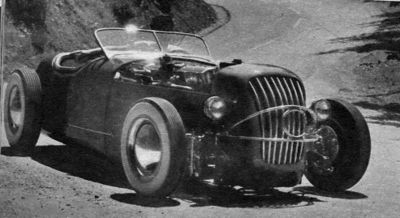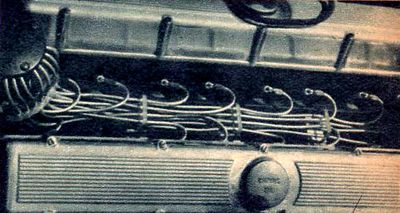Bill Carash's Roadster

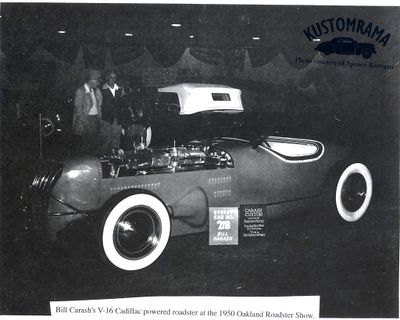
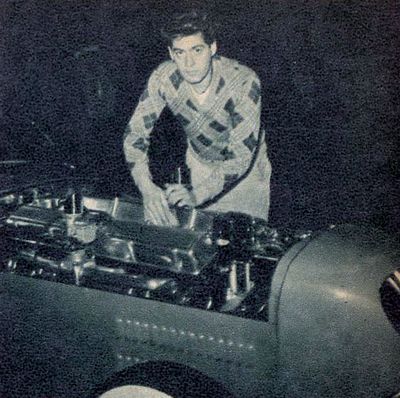






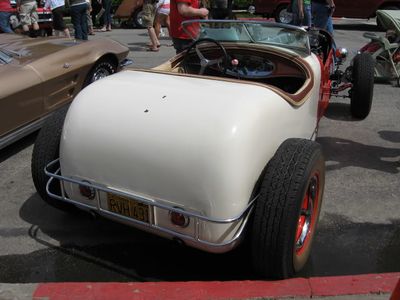
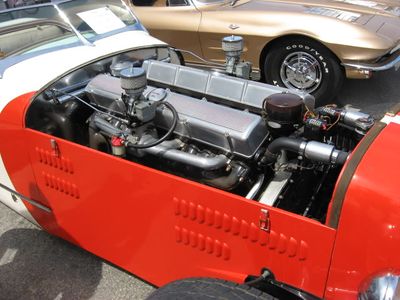
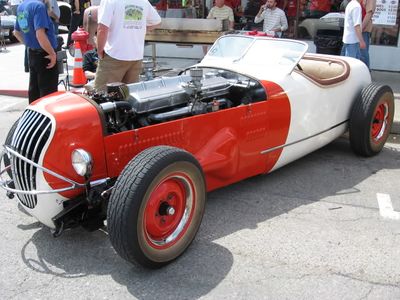
The Bill Carash Roadster is a custom built roadster designed and constructed by Bill Carash of Oakland, California. Bill was only seventeen years old when he decided to build his juggernaut. The year was 1945, and at the time most guys would start with a car and build an engine. Carash started with the engine, and built a car around it instead. Bill's roadster was powered by a retired 1932 Cadillac V-16 engine that Bill had found in a wrecking yard. The enormous engine delivered 185 bhp at 3800 rpm, running 6:1 compression ratio with a displacement of 452 cubic inches. Why bore and stroke to get cubes when you can find them waiting for you in stock equipment? And why spend good loot on bolt-on jewelry when a little hunting can lead to an engine that was made, originally to blind the eye when the hood was raised? The manifolds on the Cadillac engine were coated with black porcelain, and its long OHV rocker boxes were ribbed aluminum, polished to a mirror finish.[1] As the engine worked well, the only thing Bill did to it was to replace the original updraft carburetors with Stromberg 97's.[2]
Bill toured the wrecking yards searching for chassis parts as well. The frame, front axle and steering were old 1936 Plymouth components. Rear axle was 3.54:1 Ford with Columbia Overdrive. The front springs were Plymouth half-elliptics, rear was single Ford transverse leaf. Front wheels were Chrysler 5.50x16, and rear were Ford 7.00x16. Bill boxed in the channels for strength and added a cross member that also served as a rear engine mount. When he got through, a jack under one wheel would lift one whole side of the car.[3]
According to Mechanix Illustrated January 1951 the body parts for Bill's roadster were made by a professional shop. According to Bill's friend, Spence Kerrigan, that assisted Bill in the build, this is not correct. Bill was an expert welder, and he constructed the body framework using electrical conduit. He did get some professional help by Bill Prettyman with the sheet metal work, but did much himself. Bill did also construct the nerf bars that protected the car. Bill's parents had a small single car garage at Elston Avenue, where they lived, and it was there that Bill built the roadster. Both Bill and Spence served the military during the time the car was constructed. Once the bodywork was completed, Bill's roadster was painted by Flame Red by René Molé of René Auto Painting. Rene was a pinstriper from Oakland that operated a paint and body shop near 20th Street and Broadway. The manufacturer called the color "Flame Red", but it was more orange than red. The upholstery was done by East Oakland Auto Toggery.[2]
The build was completed in 1949. After completing it, Bill towed it to the Reno Dry Lakes to compete there. Spence recalls Bill saying that it didn't go as fast as he had hoped.[2]
In 1950 Bill entered the roadster at the National Roadster Show in Oakland, where it won first price for originality in the Street Division,[4] and a third place in the Construction Street Division.
Bill's dad, Julian Carash, tried to get his sons car to serve as Pace Car at Indy.[2] Mr. Wilbur Shaw, President of the Indianapolis Motor Speedway Corporation wrote a letter to Julian dated March 14, 1950. In the letter Shaw wrote as follows: "Dear Mr. Carash, You certainly have built a very unusual and beautiful automobile and I would like nothing better than to be able to use it for a pace car. However, we are committed entirely to American manufacturers and there just wouldn’t ever be a possibility of your getting it in as a pace car. Thank you very much for your interest and a lot of good luck with it. Sincerely yours, Indianapolis Motor Speedway Corp., WILBUR SHAW, President."[5] Bill told his friend Spence about his dad's attempt to have the roadster serve as pace car at Indy, but he never told about the letter from Wilbur Shaw, so he wonders if the letter was sent to Julian, and that Bill was unaware of it.[2]
In 1951 Bill's roadster was featured on the cover of Mechanix Illustrated January 1951. The photo for the cover was taken at the edge of Lake Merritt in Oakland, California. Spence knows as he went along for the shoot. Some time after the 1950 National Roadster Show, the car received a hood. Bill told Spence that it was made by a fellow whom Bill loaned the car to to enter in another show. The hood was constructed of a single sheet of aluminum. It was not hinged, and you had to remove it in order to work on the engine.[2]
Bill's roadster was constructed so the exhaust pipes passed through the cockpit very close to the occupant's feet. This was not a cool feature, and Spence remembers that one time he and Bill drove their cars from Oakland to Blue Lake, California they had to swap cars when the hot pipes gave the driver a hot foot.[2]
After the first roadster was completed, Bill bought a new surplus 1000 HP Allison 12 cylinder airplane engine intended for use in a P-39 airplane. Those WWII planes had engines behind the cockpit and a drive shaft to the propellor, that made adapting it fairly easy so he planned to build another car around this engine. He got an offer he couldn't refuse from someone who needed the engine for an airplane, so he sold it before the build was started.[2]
The last time Bill's roadster was licensed to drive on the road was 1956. After that the car pretty much stayed parked. Bill kept the car until he passed away in August of 1999, and he continued to tweak and work on the roadster for the rest of his life.[5], The last time Spence saw the roadster, Bill was getting it ready for the next National Roadster Show. By then it had a full hood over the engine, and it was painted flame red and white. At the time, Bill lived in Berry Creek, California.[2] Bill died before the car was ready for the show. He was divorced and had no children, so when he died, the car wound up with his nephew Craig Carash of Sandpoint, Idaho. Craig had admired the car since he was a little boy. After he got the car, Craig quickly set about getting the car running, replacing all of the fluids and rebuilding the fuel system and radiator. The first time he ever saw the car run was when he got it started for the first time. In January of 2009 Craig displayed the Carash roadster at the 60th annual Grand National Roadster Show. A special section of the show entitled “Twice in a Lifetime” featured cars that had been in the show at least once before. A few days earlier, Craig had discovered the actual plaque given to his uncle as a participant in the 1950 show. Displayed with the car were photographs and reprints of some of the period articles about the car. The two tone color scheme was a change that Bill decided to make in the late 1950s. A cream color was then applied over the original Flame red paint job. Other than that, the car was very much the way it had been in 1950.[5]
As the engine started to overheat when the car was driven in parades, Craig added an electric fan to cool the jacket water. Bill didn't intend to drive at parade speeds, so he and Spence removed the original fan and radiator shutters back in the days. The Cadillac engine was originally equipped with a radiator which had shutters to control the amount of air that passed over the radiator's fins, and thereby maintained the cooling water at the proper temprature. The shutters were automatically temprature controlled. Bill and Spence unsoldered and eliminated the thermostat and removed the shutters and linkage at a restaurant equipment manufacturing shop Spence's dad managed at 1431 Grove Street in Oakland. They used the well equipped shop after hours for various hobbies. The Cad's belt driven cooling fan was eliminated as that type of fan arrangement consumes too much horsepowers.[2] According to Craig, the total amount of horsepowers in the car is 169.[6]
Magazine Features
Hot Rod Magazine November 1949
Mechanix Illustrated January 1951
Trend Book 102 Hot Rods
Rod & Custom April 1955
References
Did you enjoy this article?
Kustomrama is an encyclopedia dedicated to preserve, share and protect traditional hot rod and custom car history from all over the world.
- Help us keep history alive. For as little as 2.99 USD a month you can become a monthly supporter. Click here to learn more.
- Subscribe to our free newsletter and receive regular updates and stories from Kustomrama.
- Do you know someone who would enjoy this article? Click here to forward it.
Can you help us make this article better?
Please get in touch with us at mail@kustomrama.com if you have additional information or photos to share about Bill Carash's Roadster.
This article was made possible by:
SunTec Auto Glass - Auto Glass Services on Vintage and Classic Cars
Finding a replacement windshield, back or side glass can be a difficult task when restoring your vintage or custom classic car. It doesn't have to be though now with auto glass specialist companies like www.suntecautoglass.com. They can source OEM or OEM-equivalent glass for older makes/models; which will ensure a proper fit every time. Check them out for more details!
Do you want to see your company here? Click here for more info about how you can advertise your business on Kustomrama.
